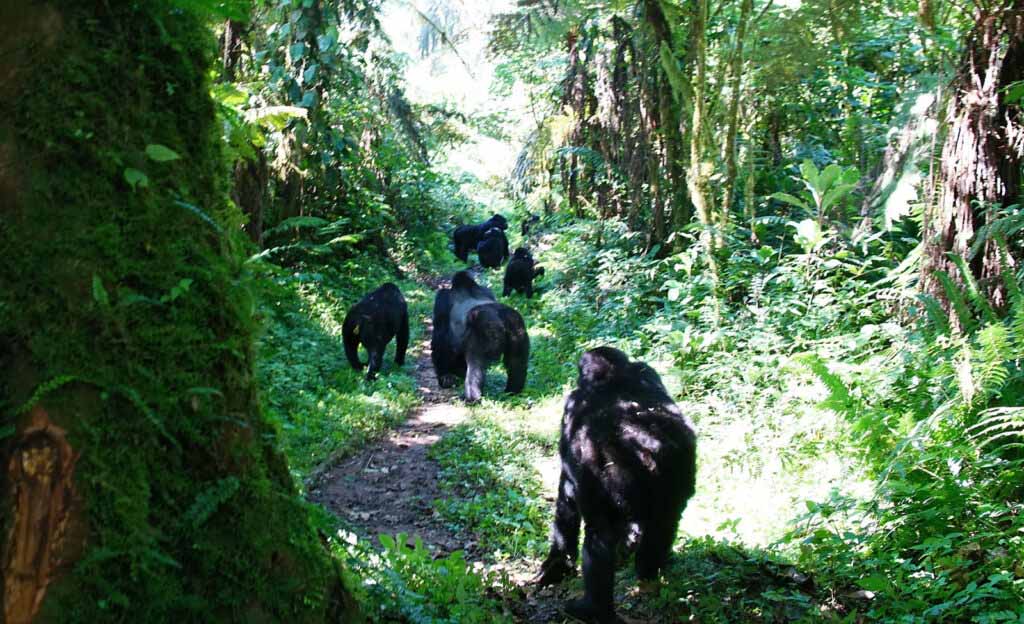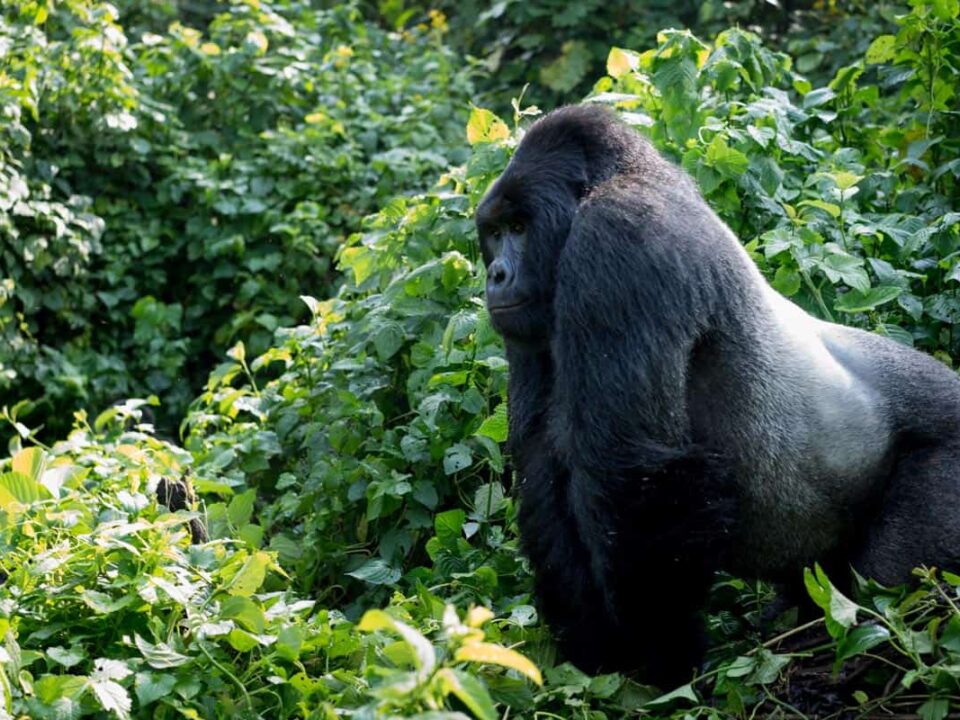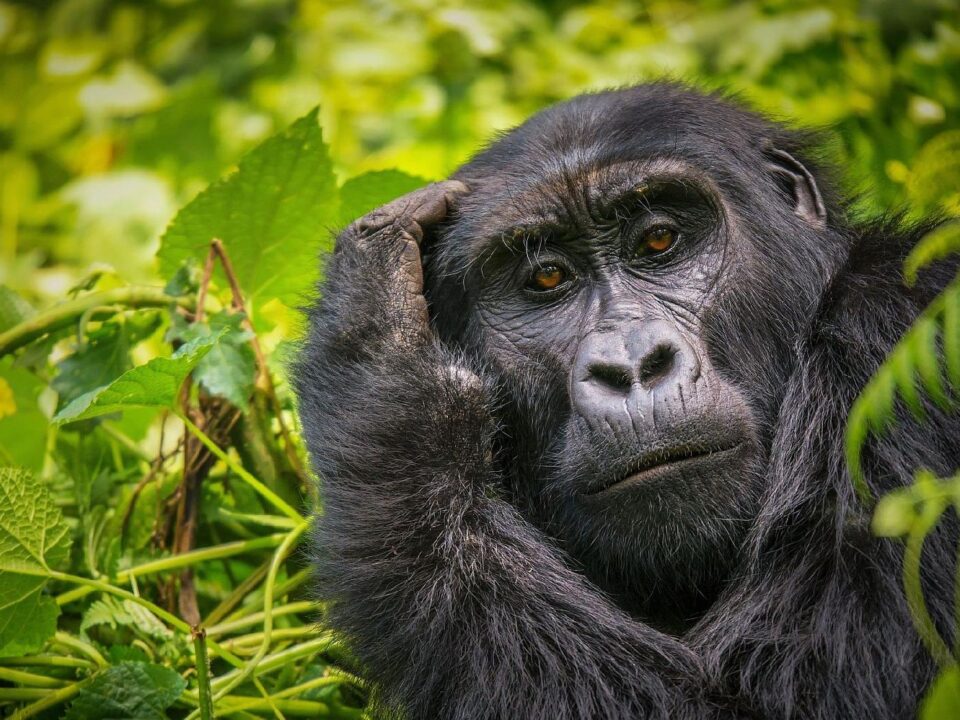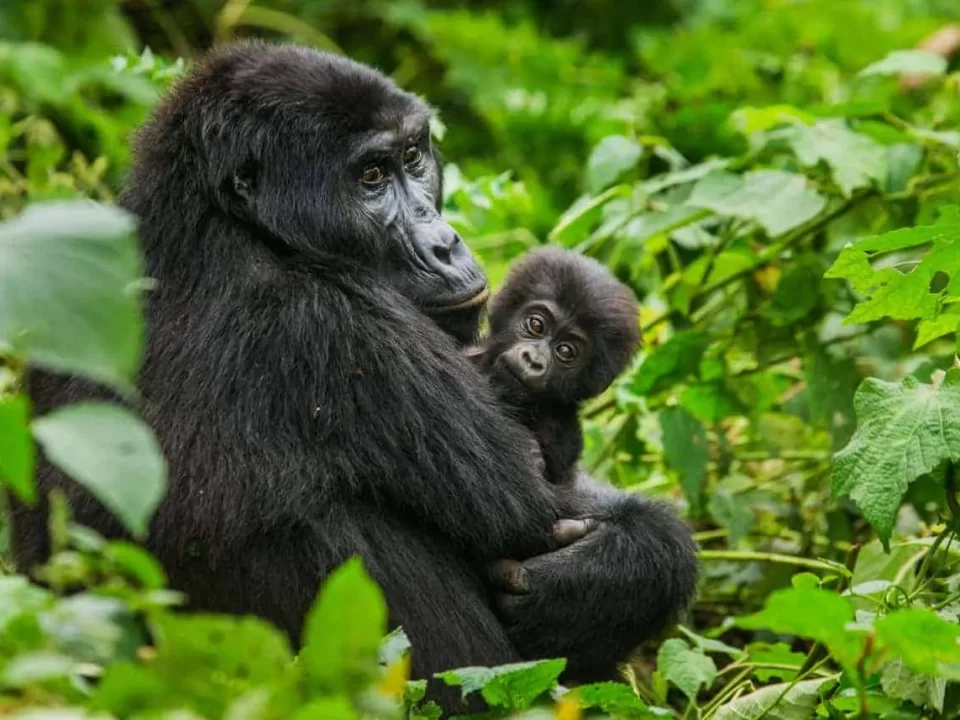Where To See And Support Mountain Gorillas In Uganda

Rwanda Gorilla and Chimp Trekking Safaris from USA
July 7, 2023
How Many Mountain Gorillas are in Uganda?
July 7, 2023Where To See And Support Mountain Gorillas In Uganda
If you’re searching for an opportunity to see and support mountain gorillas in Uganda, you’re in for a remarkable experience. With just over 1,060 individuals remaining in the world, these magnificent creatures reside in the mountainous rain forests of central Africa. Uganda plays a vital role in gorilla conservation, protecting more than half of the gorilla population and offering exceptional gorilla trekking opportunities in their natural habitat.
Mountain gorillas traverse a network of protected reserves that extend across Uganda, Rwanda, and the Democratic Republic of the Congo (DRC). The governments of these countries collaborate with international conservation programs to safeguard gorilla habitats and protect these endangered creatures.
Conservation programs for mountain gorillas heavily rely on tourism revenue to thrive. Therefore, the survival of mountain gorillas is closely linked to the support of tourists who visit them in their natural habitat.
Where to See Mountain Gorillas in Uganda
Uganda’s southwestern region, characterized by its mountainous terrain, is the primary destination to observe mountain gorillas in the country. These gorillas inhabit the high mountains, ranging from 2,400 to 3,900 meters in elevation, where temperatures often drop below freezing.
The lush rainforests at these high altitudes provide an abundance of plants and fruits that sustain gorilla populations in these challenging environments. Travelers visiting Uganda to see mountain gorillas embark on a roughly 10-hour journey from the international airport into the mountainous landscapes, traversing deep valleys and gorges.
The Uganda Wildlife Authority oversees the conservation of two mountain gorilla populations: one in Bwindi Impenetrable National Park and the other in the Virunga Volcanoes. The Virunga conservation site spans the borders of the three countries, with Mgahinga Gorilla National Park serving as the Ugandan portion of the protected area.
Tourists can witness mountain gorillas in the renowned Bwindi Impenetrable National Park, which safeguards nearly half of the global gorilla population. Additionally, the lesser-known Mgahinga National Park offers excellent opportunities for gorilla viewing. Bwindi Impenetrable National Park provides more extensive accommodation options for gorilla safaris in Uganda.
Mgahinga Gorilla National Park: An Intimate Encounter
Situated on Uganda’s southwestern border with the DRC to the west and Rwanda to the south, Mgahinga National Park is the smallest of all Uganda’s national parks. However, it is fortunate to be home to the endangered mountain gorillas. As part of the Virunga Mountains shared among Uganda, Rwanda, and the DRC, Mgahinga hosts approximately 600 mountain gorillas that freely roam between Mgahinga, Volcanoes National Park (Rwanda), and Virunga National Park (DRC).
Within Mgahinga Gorilla National Park, only one gorilla group, known as the Nyakagezi Gorilla Family, has been habituated for tourism. Each day, eight permits are available for tourists to see the mountain gorillas.
Nyakagezi Gorilla Family, residing within the park’s 34 square kilometers of gorilla sanctuary, is the main attraction. Daily gorilla trekking excursions set off from the park headquarters, allowing a group of eight tourists, accompanied by two armed rangers and an expert guide, to observe the mountain gorillas up close.
While gorilla trekking is the park’s highlight, Mgahinga Gorilla National Park is the only place in Uganda where visitors can also see golden monkeys. These unique primates, consisting of a habituated family of around 30 individuals, dwell in Mgahinga’s bamboo forests, offering an additional wildlife encounter alongside gorilla trekking.
Visitors to Mgahinga can also embark on hikes to three dormant volcanoes that span the park’s boundaries. The most challenging of these peaks is Mount Muhavura, which reaches an elevation of 4,127 meters and features a small crater lake. Mount Sabinyo, the oldest volcano in the Virunga range, stands at 3,669 meters, while Gahinga Peak, the smallest of the three, measures 3,474 meters and lies between Muhabura and Sabinyo. These mountains attract numerous tourists who wish to combine gorilla trekking with mountain climbing in Uganda.
The area around the summit is characterized by woody vegetation, bamboo, and dwarf shrub heath, creating a striking contrast with the dense rainforest found on the lower slopes. Exploring Mgahinga after a gorilla trek can be highly rewarding, as the park is home to 115 recorded bird species and offers scenic nature walks.
The luxury Gahinga Lodge is the ideal accommodation option for those seeking to see mountain gorillas in Mgahinga. However, travelers on a budget can find a wide range of choices just an hour’s drive away in Kisoro Town.
While Bwindi Impenetrable National Park is the more popular choice for gorilla trekking, particularly if permits are available, Mgahinga National Park offers a more secluded experience with fewer crowds.
Bwindi Impenetrable National Park: A Sanctuary for Gorillas
Covering an area of 331 square kilometers, Bwindi Impenetrable National Park is a pristine rainforest located on the edge of the Albertine Rift. This park safeguards approximately half of the world’s mountain gorilla population, making it the most popular destination for gorilla sightings in Uganda. The park is home to 19 habituated gorilla families available for tourism.
Bwindi Impenetrable National Park is divided into four sectors spread across its boundaries:
Buhoma Sector:
Located in the park’s northern region, the Buhoma Sector is home to four gorilla groups available for trekking. It is particularly popular for budget-friendly gorilla safaris, as it offers a wide selection of affordable lodges and camps along the main park entrance. Buhoma also provides convenient access to Queen Elizabeth National Park for wildlife safaris. Visitors can reach the Buhoma Sector through Kihihi Airstrip, situated north of Bwindi Impenetrable Forest and beneath Queen Elizabeth National Park.
Nkuringo Sector:
Situated at the southern boundary of Bwindi Impenetrable Forest on Nteko Ridge, the Nkuringo Sector is home to three gorilla families available for trekking. This sector is renowned for its captivating gorilla families and was the home of Rafiki Silverback, a gorilla tragically killed during the COVID-19 lockdown in 2020. Many trekkers opt to hike between the Buhoma and Nkuringo Sectors either before or after their gorilla encounter. Nkuringo is also popular among luxury trekkers seeking to see gorillas in the nearby Rushaga Sector, which offers limited high-end accommodation options and is approximately an hour’s drive from Nkuringo. Access to the Nkuringo Sector can be obtained through Kisoro Airstrip, which is a three-hour drive away, or by taking a 10-hour journey from Entebbe via Kisoro Town.
Rushaga Sector:
Located on the southeastern border of Bwindi Impenetrable National Park, the Rushaga Sector is home to eight gorilla groups available for trekking, more than any other sector in Bwindi. Rushaga is renowned for its high number of habituated gorillas and is the exclusive location for the Habituation Experience. This unique experience allows trekkers to spend four hours with a gorilla family that is still in the process of habituation. Rushaga offers excellent opportunities for forest camping and birding, making it a popular choice for nature enthusiasts. It also provides convenient access to Rwanda, with flights available through Kigali, making it a shorter route (four hours) for travelers with an East African Visa compared to the 10-hour drive from Entebbe International Airport.
Ruhija Sector:
Situated in the northeastern part of Bwindi, the Ruhija Sector is less frequented by tourists but offers four gorilla groups available for trekking. While accommodation options in this sector are limited, Ruhija serves as a favorable base for budget travelers. The sector’s location allows for convenient access between the Buhoma and Kabale areas, although the roads are unpaved and may require more time for travel.
Choosing the Best Sector in Bwindi for Gorilla Viewing
The choice of sector for gorilla trekking depends on permit availability for your preferred travel dates and your accommodation preferences. All the sectors offer the same gorilla trekking experience at a permit price of USD800 per person, except for the Rushaga Sector, which offers the exclusive Habituation Experience at a higher permit price of $1,500 per person.
Supporting Mountain Gorilla Conservation in Uganda
Habitat loss and poaching pose significant threats to mountain gorilla conservation. Human settlements near park boundaries create a thin buffer zone between villages and gorilla sanctuaries. The local communities heavily depend on gorilla tourism and farming on the highland slopes.
As gorilla tourism gains popularity in Uganda, visitors have various opportunities to support conservation initiatives. One popular way is by hiring a porter. These young individuals from surrounding communities assist tourists in navigating the challenging terrain during gorilla trekking. By hiring a porter, visitors contribute to the local economy and help deter individuals from engaging in poaching activities.
Engaging in community-led cultural initiatives, such as the Batwa Cultural Tours, also directly benefits the surrounding communities. The Batwa tribe, who once occupied the forests but were displaced for wildlife conservation, still rely on the forests for their livelihoods. Supporting their cultural initiatives contributes to the preservation of the natural forests that are crucial for gorilla habitats.
International organizations like the Wildlife Conservation Society (WCS), the International Gorilla Conservation Programme (IGCP), and the Dian Fossey Gorilla Fund offer opportunities for volunteers to support gorilla conservation efforts. These organizations lead global initiatives in protecting and studying gorillas while helping local communities develop their conservation capabilities.
Planning Your Gorilla Safari with Trek Africa Expeditions
To embark on a gorilla safari in Uganda, book your trip with Trek Africa Expeditions. Choose from our selection of trips, and simply send us a message with your preferred dates. We will handle the arrangements for your gorilla permits, accommodation, and transportation.
With over 20 years of experience organizing successful gorilla safaris in Uganda, Trek Africa Expeditions is well-equipped to create a memorable journey for you. Our extensive reviews and expertise in the field ensure a seamless and enriching trip to Africa.
Contact us now by emailing info@trekafricatours.com, and our team of gorilla trekking consultants will provide you with personalized recommendations and assistance.




